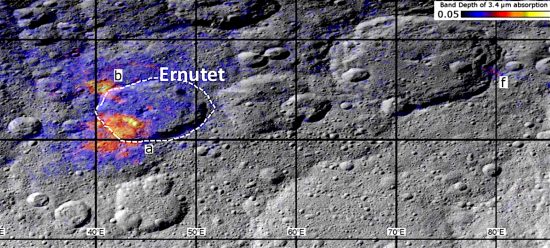
Distribution of organic molecules on Ceres. Credit: NASA / Rendering by Hannah Kaplan.
September 4, 2020
Editor’s note: The Picture of the Day will take a short recess today. Meanwhile, please enjoy this article from the archives.
There are many carbon-based molecules in space and on rocky bodies.
Tholins are large organic molecules found off the Earth, sometimes in space and sometimes in some of the coldest environments. They do not exist naturally on Earth, because they would be immediately dissociated by ultraviolet light and atmospheric oxygen. They can be synthesized in laboratory isolation, however, by sending electric arcs through various combinations of methane and ammonia.
Tholins are primarily a rusty color, so Titan’s coloration might be explained by the presence of tholins in its atmosphere, where there is almost no oxygen. The Cassini spacecraft also detected “large molecules” when it flew within 800 kilometers of Titan’s surface. The molecules remain unknown, however, because Cassini did not carry the necessary instruments to identify them.
It is not a coincidence that electric arcs are used to create tholins in the laboratory. The Huygens probe found high concentrations of charged particles in the lower atmosphere of Titan, so intense electrical activity could have been responsible for the formation of organic molecules there, as well. Perhaps the reddish-brown “soot” that covers several of Saturn’s moons also contains tholins.
Infrared data from the Spitzer Space Telescope indicates that dust streams composed of tholins also flow in and around the Small Magellanic Cloud. The material exists in a structure known as the Magellanic Stream, which is composed mainly of hydrogen gas, with tholin compounds mixed in. As noted in a previous Picture of the Day, the Stream is filamentary. Filaments in ionized gas clouds are a sign of electric charge moving through dusty plasma. Electric charge creates vortex structures that gradually change into distorted wisps and curlicues of glowing matter.
According to a recent press release, astrophysicists studying data downloaded from the Dawn spacecraft note that large patches on the surface of the dwarf planet, Ceres, exhibit carbon-based compounds. How did they arrive on Ceres? One suggestion is organic-rich meteors or comets. However, as the announcement acknowledges, heat from an impact would destroy cometary compounds.
So, where do the hydrocarbons come from? Some astrobiologists suggest that interstellar space is the source, because comets, which are believed to have formed in interstellar space, have hydrocarbons in their tails. In fact, there are dozens of 10+ atom molecules in space, including acetone, ethylene glycol, and other aromatic hydrocarbons.
In an Electric Universe, however, comets are formed in plasma discharges from the gas giant planets. So the hydrocarbons in comet tails, the hydrocarbons on Titan, and the hydrocarbons in intergalactic space have the same source: electricity.
Stephen Smith
The Thunderbolts Picture of the Day is generously supported by the Mainwaring Archive Foundation.












